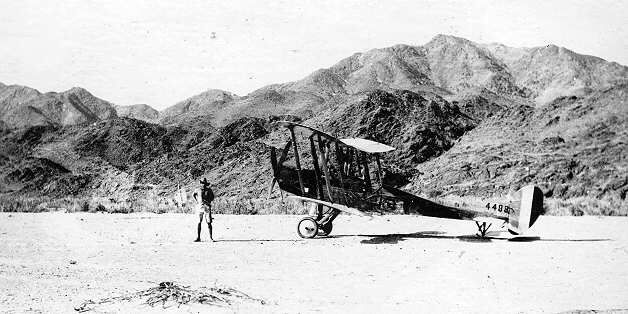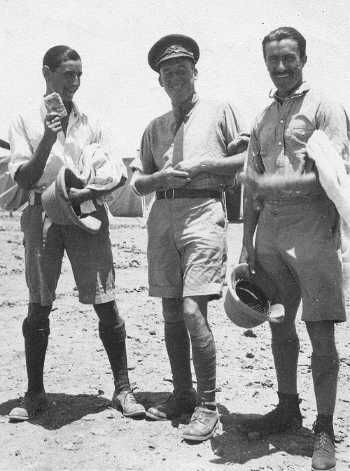
BE2c 4488 with Capt Henderson at the Advanced Landing Ground in the Wadi Hamdh. This landing ground was almost surrounded by the hills shown, making both landings and take-offs a rather precarious business. (See Henderson's map on page 8)
LAWRENCE'S AIR FORCE |
| < back to Hejaz Page ... < previous | 1 | 2 | 3 | 4 | 5 | 6 | 7 | 8 | 9 | 10 | 11 | 12 | 13 | next > |

BE2c 4488 with Capt Henderson at the Advanced Landing Ground in the Wadi Hamdh. This landing ground was almost surrounded by the hills shown, making both landings and take-offs a rather precarious business. (See Henderson's map on page 8) |
|
Three hostile machines were seen in the air, described as two Aviatiks and a monoplane (probably a Pfalz A.II), all of No 3 Ottoman Squadron. Colonel Wilson decided to move the Flight to Yenbo to be nearer enemy concentrations along the railway, and Major Ross left by camel to reconnoitre for an advance landing ground in that region. Meanwhile, BE2c 4473 was declared unfit for further duties, so was dismantled and crated for shipment back to Suez. The proposed move to Yenbo was not to everyone's liking, the CO and other officers preferred a move to El Wejh along the coast, some 175 miles further north. Colonel Wilson eventually agreed and on 12 March, an advance party of 10 men, two NCOs with Lt D.N. Thomson and 2Lt J.M. Batting sailed for Wejh in HMS Lama. Four days later three machines, 4478, 4488 and 5421, were due to proceed by air via the forward landing ground at Bir Abbas. 4478 suffered engine trouble caused by a cracked cylinder and had to remain behind to have a new engine fitted but left the next day. An abandoned Turkish landing ground was found nearby with one temporary hangar and some bits of plywood and fittings, which were part of a crashed Aviatik. Locals said that the observer had suffered broken legs and that the pilot had been killed. A message was sent to GHQ requesting the supply of 50 delayed-action bombs and suitable racks – objective railway! A forward landing ground was established 96 miles east of Wejh, towards the Hejaz Railway. On 30 March 1917, a reconnaissance flight to Hadiya to observe the railway lines was made by two machines. 4483 had to force-land owing to lack of fuel and the pilot having a totally inaccurate map. It was obvious that air and ground reconnaissances were again needed to produce up-to-date maps and so Crossley tender and camel reconnaissances across the scrub were carried out. One of these covered 150 miles by car but only 48 miles by camel! The sure-footed 'ship-of-the-desert' was really the ideal and more direct mode of transport. The early days at the new aerodrome were spent getting the site in efficient order – stores off-loaded, hangars erected, bomb store established, machine-gun emplacements for defence, fuel store etc. Captain Lawrence reported that information from Turkish deserters indicated that the three enemy aeroplanes at Medina had been destroyed by fire. |
The detachment's new forward landing ground was to be at Um Jarad in the Wadi Hamdh, giving one and a half hours flying time to the railway at Toweira. The full complement at Wejh was 11 officers and 39 other ranks. Having settled in at Wejh, the future offensive was to be entirely against the Hejaz Railway. It being April, the weather was much better, but the heat was much greater and this was badly affecting the machines' engine cylinders, which were now prone to cracking – a constant problem in the weeks to come. On 22 April 1917, Major Ross handed over command of the Flight to Captain F.W. Stent, who understood and spoke Arabic. The machines were well overdue for complete overhaul, their fabric was sagging and woodwork inclined to cracking. The mechanics were doing a wonderful job in keeping them going, for there were to be many more weeks of wartime flying ahead under these trying conditions. 
'The Three Graces' - an informal moment. Capt T. Henderson (with biscuit), Lt L.H. Gilman and the CO Capt F.W. Stent. |